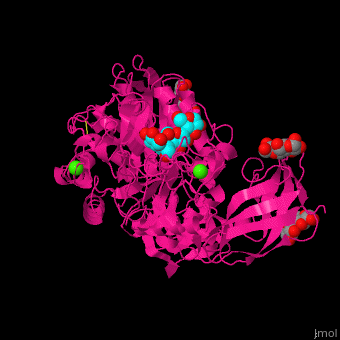Function
- Glycosyltransferase (GT) are enzymes which catalyze the transfer of monosaccharide to alcohol, carbohydrate, protein or inorganic phosphate[1].
- Galactosyltransferase (AGT) is a GT which catalyzes the transfer of galactose during the synthesis of polysaccharides[2].
- Beta-1,4-galactosyltransferase (BGT) is the catalytic subunit of lactose synthase of which Alpha-lactalbumin is the regulatory subunit. Lactose synthase synthesises lactose from UDP-galactose and glucose[3]. See Human Lactose synthase(Hebrew).
- Fucosylglycoprotein 3-AGT (GTB) or histo-blood group ABO system transferase is the basis of the blood ABO system. It involves 3 carbohydrate antigens: A, B and H.
- Flavonoid GT glycosylates flavonoids (plant metabolites with two phenyl rings and one heterocyclic ring)[4]. For details on flavonoid GT see Vitis vinifera Flavonoid 3-O-Glucosyltransferase (Vv3GT).
- Cyclodextrin GT produces cyclodextrin from starch[5].
- UDP GT has a role in xenobiotics metabolism and metabolic waste[6].
- C-GT catalyzes the formation of C-glycosidic bonds[7].
- peptidoglycan GT synthesises the glycol strands of the bacterial walls' peptidoglycans [8].
- Pseudo-GT VldE catalyzes the condensation of 2 pseudo sugars to a product with an alpha, alpha-N-glycosidic bond[9].
Relevance
Individuals with blood type A, B and AB has glycosyltransferase activitiy which converts antigen H to A or B. Individuals with blood type O lack this activity. For details see Human ABO(H) Blood Group Glycosyltransferases.
Disease
Mutations in mannose GT can cause muscular dystrophy and neuronal migration disorder[10].
Structural highlights
The of cyclodextrin GT contains [11]. Water molecules are shown as red spheres.
3D structures of glycosyltransferase
Glycosyltransferase 3D structures

